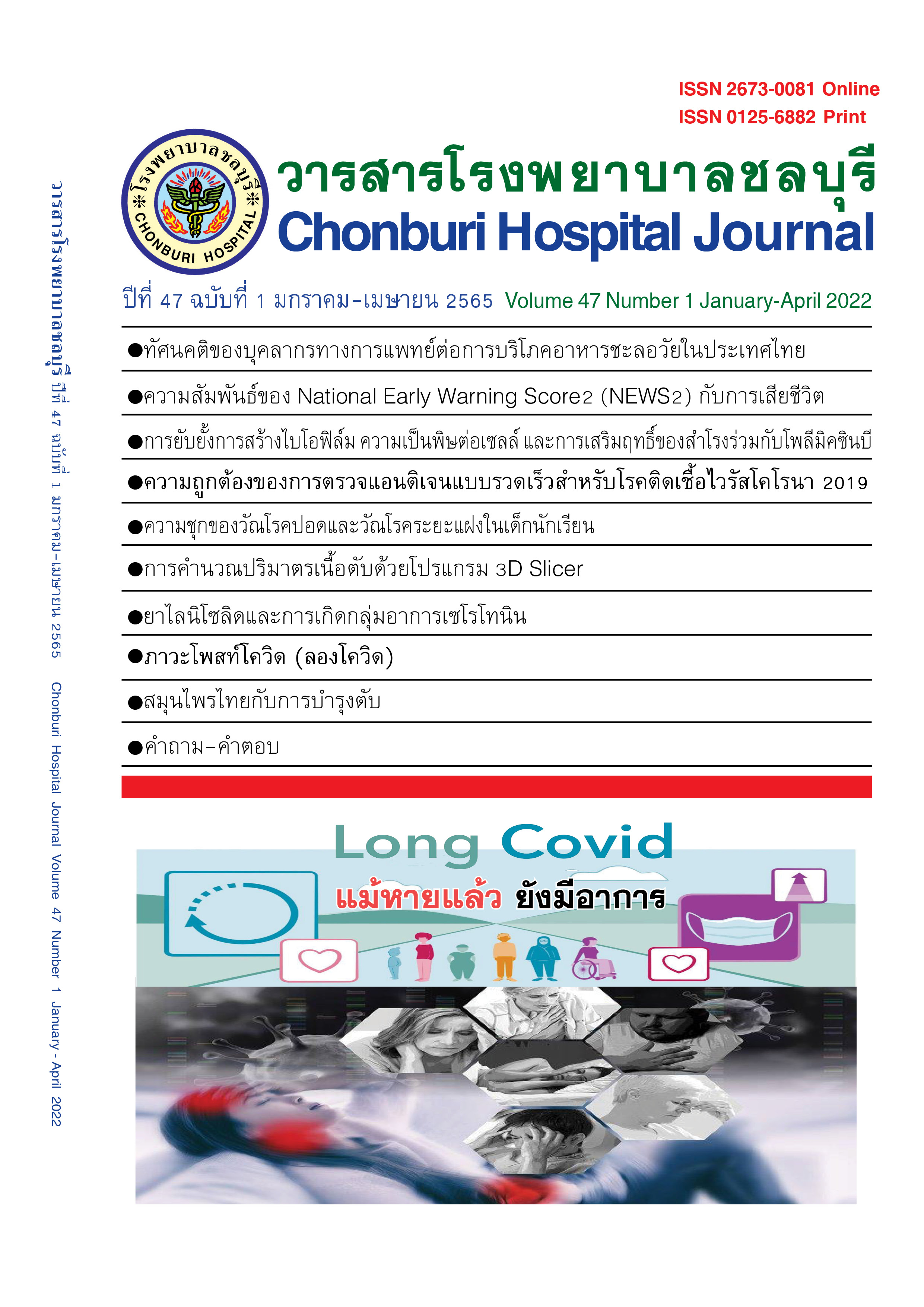The association of national early warning score 2 (NEWS2) to in-hospital mortality of patients visiting emergency department
Abstract
Background : In each year, there were a lot of patients visiting emergency department so triage and monitoring were necessary. Some patients got worse after they were triaged. This study was designed to use national early warning score 2 (NEWS2) in emergency department to predict 24 hours death.
Objectives : This study aims to determine the ability of National Early Warning Score2 (NEWS2) to prognosticate in-hospital mortality within 24 hours
Methods : A single-center prospective observational study was conducted in Chonburi hospital, a tertiary-care center, over a month. We enrolled all adult patients admitted to the hospital. Their physiologic parameters were recorded at the beginning of treatment to the time of admission. NEWS2 was subsequently calculated into initial NEWS2 and final NEWS2. Logistic regression models and the Area Under Receiver Operating Characteristic (AUROC) quantified the association between outcomes and NEWS2.
Result : 407 patients were enrolled to the study. Final NEWS2 was a better predictor for in-hospital mortality (RR 2.07; 95%CI 1.6-2.68, P< 0.001) which the AUROC was 0.94 (95%CI 0.90-0.97, P< 0.05). Additionally, A final NEWS2 of 5 or more exhibited a sensitivity of 100% and a specificity of 71.9% to detect in-hospital mortality within 24 hours.
Conclusion : NEWS2 is a fundamental and practical tool of healthcare providers for predicting in-hospital mortality within 24 hours.
References
Trauma and Emergency Administration Unit. Annual Report of Admission statistics 2015-2017 A.D: Chonburi hospital; 2018. p. 13-502.
Jo S, Yoon J, Lee JB, Jin Y, Jeong T, Park B. Predictive value of the National Early Warning Score-Lactate for mortality and the need for critical care among general emergency department patients. J Crit Care 2016;36:60-8.
Churpek MM, Snyder A, Han X, Sokol S, Pettit N, Howell MD, et al. Quick Sepsis-related Organ Failure Assessment, Systemic Inflammatory Response Syndrome, and early warning scores for detecting clinical deterioration in infected patients outside the intensive care unit. Am J Respir Crit Care Med 2017;195:906-11.
Churpek MM, Snyder A, Sokol S, Pettit NN, Edelson DP. Investigating the impact of different suspicion of infection criteria on the accuracy of quick Sepsis-related Organ Failure Assessment, Systemic Inflammatory Response Syndrome, and early warning scores. Crit Care Med 2017;45:1805-12.
Smith GB, Prytherch DR, Jarvis S, Kovacs C, Meredith P, Schmidt PE, et al. A แomparison of the ability of the physiologic components of medical emergency team criteria and the U.K. National Early Warning Score to discriminate patients at risk of a range of adverse clinical outcomes. Crit Care Med 2016;44:2171-81.
Spagnolli W, Rigoni M, Torri E, Cozzio S, Vettorato E, Nollo G. Application of the National Early Warning Score (NEWS) as a stratification tool on admission in an Italian acute medical ward: a perspective study. Int J Clin Pract 2017;71:3-4.
FY Liu, J Qin, RX Wang, XL Fan, J Wang, CY Sun, el al. A prospective validation of National Early Warning Score in emergency intensive care unit patients at Beijing. Hong Kong Journal of Emergency Medicine 2015;22:137-44.
Smith GB, Prytherch DR, Meredith P, Schmidt PE, Featherstone PI. The ability of the National Early Warning Score (NEWS) to discriminate patients at risk of early cardiac arrest, unanticipated intensive care unit admission, and death. Resuscitation 2013;84:465-70.
Abbott TEF, Torrance HDT, Cron N, Vaid N, Emmanuel J. A single-centre cohort study of National Early Warning Score (NEWS) and near patient testing in acute medical admissions. European Journal of Internal Medicine 2016;35:78-82.
Jo S, Yoon J, Lee JB, Jin Y, Jeong T, Park B. Predictive value of the National Early Warning Score–Lactate for mortality and the need for critical care among general emergency department patients. Journal of Critical Care 2016;36:60-8.
Shaw J, Fothergill RT, Clark S, Moore F. Can the prehospital National Early Warning Score identify patients most at risk from subsequent deterioration? Emerg Med J 2017;34:533-7.
Supattra U, Rungsun B, Jaruwan B, Julawan K. National Early Warning Score (NEWS) at ICU discharge can predict early clinical deterioration after ICU transfer. Journal of Critical Care 2018;43:225–9.
Royal College of Physicians. National Early Warning Score (NEWS) 2: Standardizing the assessment of acute-illness severity in the NHS. Updated report of a working party. London: RCP; 2017.
Pimentel MAF, Redfern OC, Gerry S, Collins GS, Malycha J, Prytherch D, et al. A comparison of the ability of the National Early Warning Score2 to identify patients at risk of in-hospital mortality: a multi-center database study. Resuscitation 2019;134:147-56.
Lee YS, Choi JW, Park YH, Chung C, Park DI, Lee JE, et al. Evaluation of the efficacy of the National Early Warning Score in predicting in-hospital mortality via the risk stratification. J Crit Care 2018;47:222-6.
Redfern OC, Pimentel MAF, Prytherch D, Meredith P, Clifton DA, Tarassenko L, et al. Predicting in-hospital mortality and unanticipated admissions to the intensive care unit using routinely collected blood tests and vital signs: development and validation of a multivariable model. Resuscitaion 2018 Dec;133:75-81
Downloads
Published
Issue
Section
License

This work is licensed under a Creative Commons Attribution-NonCommercial-NoDerivatives 4.0 International License.
บทความที่ได้รับการตีพิมพิ์เป็นลิขสิทธิ์ของวารสารโรงพยาบาลชลบุรี
